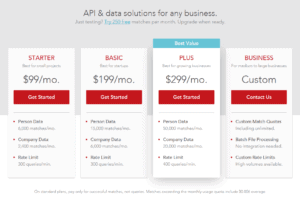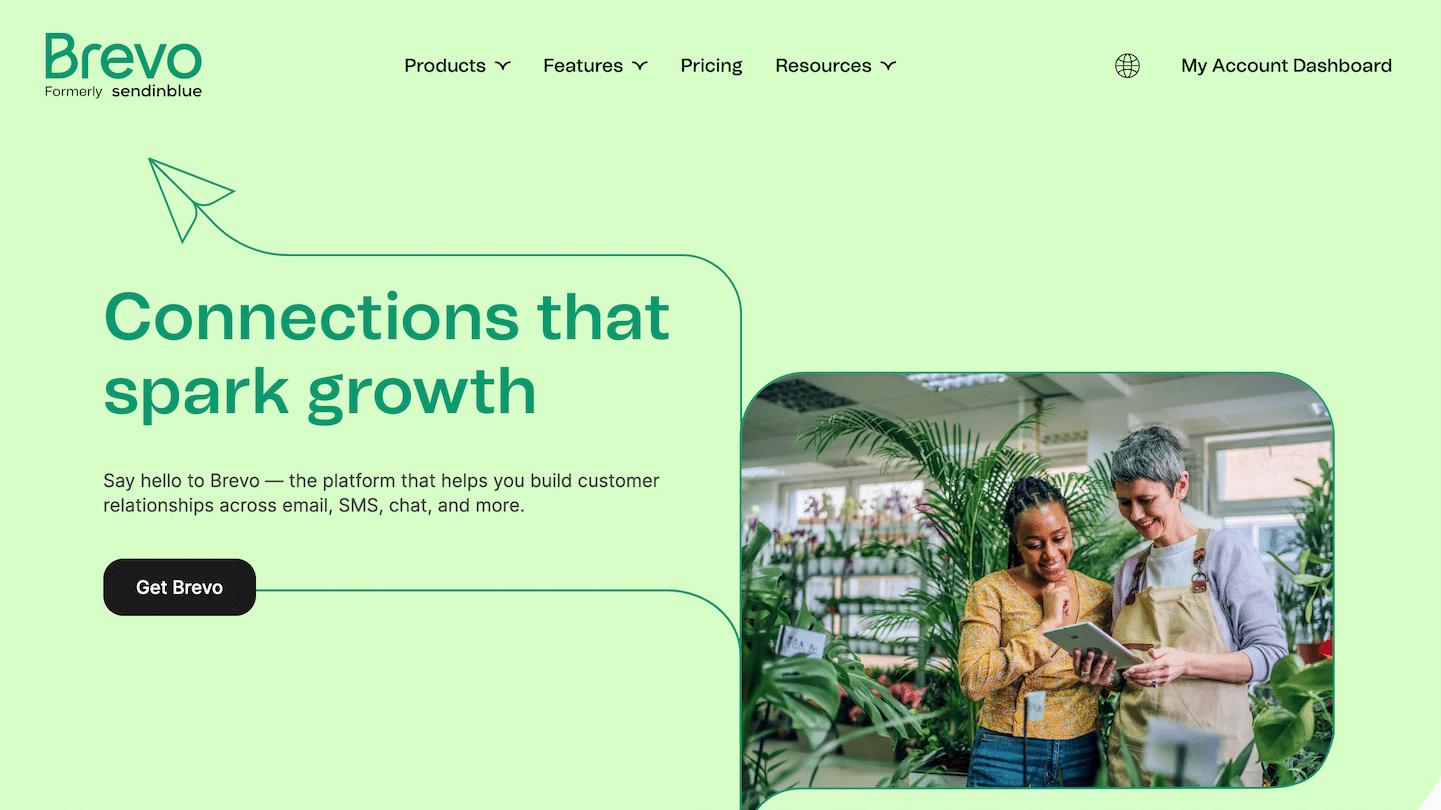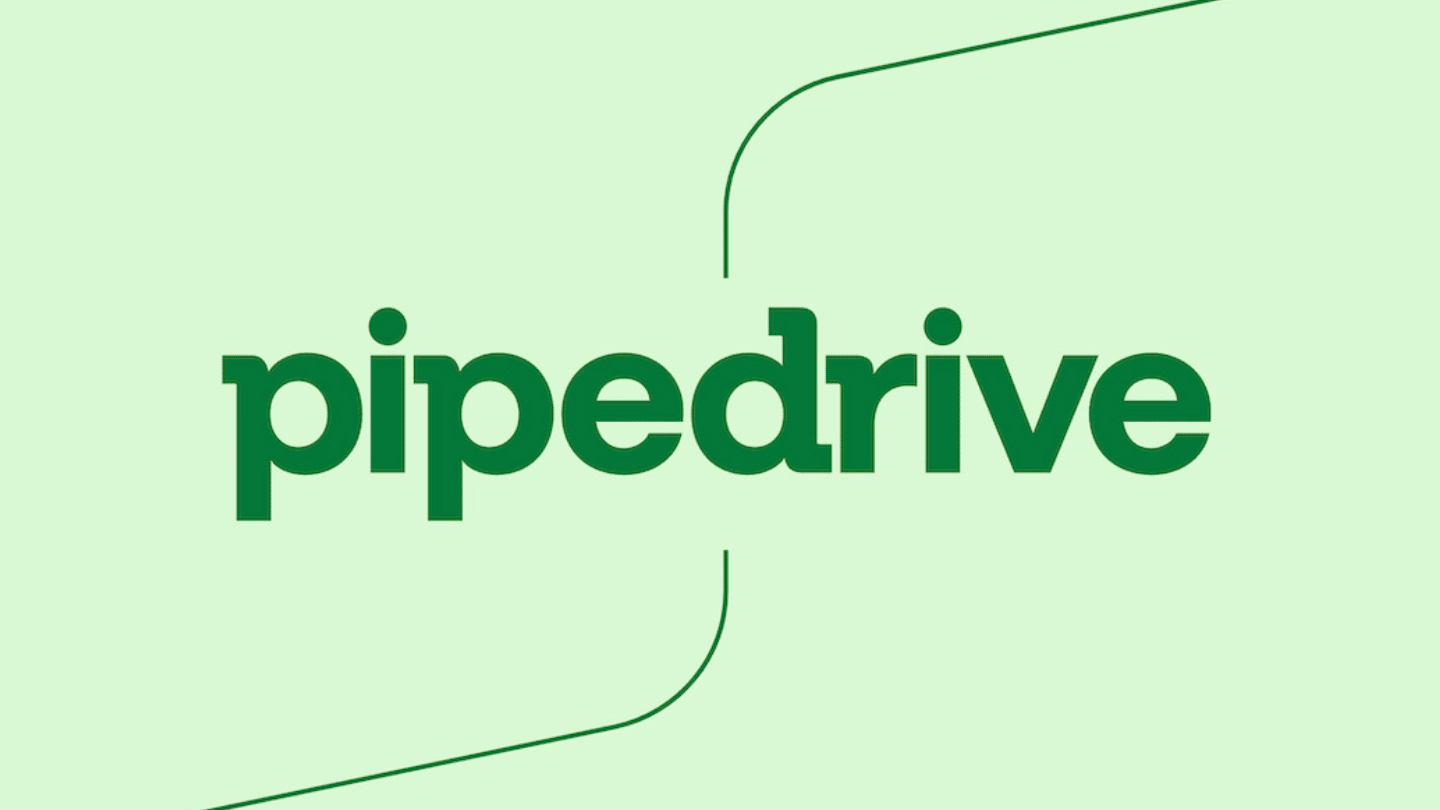You have information about your customers and prospects. But do you have enough? Email enrichment allows a company to complete its database with additional information on its customers or prospects in exchange for their email address. It is therefore a fundamental tool for any company aiming to combat the obsolescence or incompleteness of its database and aiming to have information with high added value. Indeed, most of the time, a single email address coupled with basic information (last name, first name, postal address) is not enough to determine if your prospect has a great potential or not. Thanks to email enrichment, in exchange for the email address of a contact file, you will have access to his full name, his city, his social network profiles, or even the NAF code and the turnover for companies. It is therefore a very effective tool!
Let’s take the example of the white paper. In concrete terms, your company offers other companies in its market a set of solutions to address the following topic: the purchasing behaviour of French consumers on the mobile market. Obviously, to produce your white paper you will need a lot of information, both qualitative (surname, first name, age, sex, etc.) and behavioural (opening rate, click rate), from consumers on this market, in order to be as accurate as possible. This requires email enrichment, which has become essential.
In this article, we look at the many advantages of email enrichment, the ways in which it can be done and the cost of such an operation. We are talking about enriching a contact file via email, which is different from email appending.
Sommaire
Email enrichment: focus on three classic use cases
Knowing your email base
How can you be effective in an acquisition campaign if inactive email addresses are eating away at your database? There is no chance of getting new customers by sending emails to people who no longer wish to receive them! Worse, you risk being blacklisted, which would be fatal for your deliverability rate.
Email enrichment firstly allows a company to have access to qualitative information in exchange for theemail address of their prospects, for example. The first objective of email enrichment is to build up a signalling block: in concrete terms, this means firstly having more information on the contacts in the database and then making this data more accurate to optimise its use. But what is the point of knowing your database? The better and more complete the information collected, the more precise the company will be able to know its prospects, and the better its relationship with them. The interest of knowing your database is therefore, for example, to be able to target the prospects that you need to follow up to optimise your acquisition campaigns, avoiding those who ignore your emails.
Imagine that you are a company specialising in the sale of household linen and that you are setting up a special offer for the winter sales. For youremail campaigns, you have a list of contacts whose main information is name, gender, age, email address and whether they are a customer or a prospect. In order to enrich this data, you can also enrich the email address in order to collect information such as the title of the profession of your contacts, their location, their last purchase on your site, their purchasing potential, their purchasing behaviour, whether they are clickers/openers, whether they have subscribed to your newsletter, etc.: all information that you could use to enrich your list. This is all information you may need to define the contacts you will target for your campaigns!
Segmenting your email base
The second central point concerns the segmentation of the database: in other words, the way in which a company sorts through all the data it has on its customers/prospects.

Sorting a database is doubly necessary.
Firstly, it is useful to clean up your base. This can be done in three classic ways:
- Firstly, when enriching one’s database, it is not guaranteed that all the information collected is of good quality or relevant to the professional activity. Some of it is simply not fundamental. For example, if you almost exclusively retain your customers by email, information about the contact’s phone number is not fundamental to you.
- Similarly, it is possible for a contact to be present twice (or more) in a database, which is not only problematic but also unnecessary. This is known as a “duplicate”. The interest of email enrichment is to eliminate these duplicates by cleaning up the database.
- Finally, email enrichment allows for deduplication: in the same spirit as deduplication, this tool allows for the deletion of contact files present in different databases which are then grouped together.
The second point is that it also makes it possible to optimise the use of this database by dividing it into different groups of contacts with similar characteristics. This is called segmentation: dividing a database into different groups of contacts with similar characteristics. It is essential to use this method, particularly in order to draft messages that have an impact on predefined and interested targets. This is the whole point of email enrichment, which makes it possible to have a whole battery of complete and relevant data at one’s disposal and makes segmentation more advanced, but above all more effective by including behavioural data.
Behavioural segmentation can include two components: the reactivity rate of your contacts following an email campaign (the number of clickers divided by the number of openers) and commercial behaviour (which customer has signed up for a trial offer, a subscription, etc.).Two clear examples of the usefulness of behavioural segmentation: 1/you can compare the prospects who clicked on your last two newsletters, which gives a good indication of the warmth of this lead; 2/it is possible to segment according to the last purchase made on your site: this makes it possible to introduce, via personalised emails, new products that are similar or complementary to the product initially purchased.
Having access to this type of information makes it possible to mark differences between Internet users, to bring together those who behave in the same way and therefore to segment the database in order to set up coherent marketing strategies corresponding to each of these segments.
A little advice from Salesdorado
Note that there are a growing number of providers capable of cleaning your database. However, the Datavalidation API is an atypical example, since in addition to allowing you to quickly perform verification tests of email addresses present in a database (correction of [email protected] in ), this tool allows you to retrieve information on the behaviour of a contact: which email in the database is an opener, a clicker, etc.
Scoring your email base
For a company, scoring consists of assigning a score to all the contacts in its database, whether they are prospects or already customers. It is a decision-making tool. In concrete terms, it enables the company to determine “look-alike” customers, identify new high-potential prospects, but above all to rank its database. It is therefore a statistical classification method that allows the optimisation of the use of its database for a loyalty campaign, for example, by answering this type of question: “how can we retain customers already acquired and avoid losing them? Scoring its database is therefore fundamental: it allows a company to target as a priority the customers with the highest score, and therefore those who will be the most receptive to your emails: this is how a company will be able to optimise its deliverability rate!
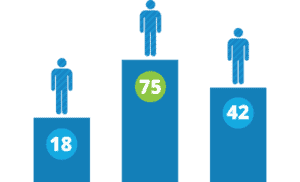
Email enrichment is very useful to improve the scoring of a database, by adding qualitative and behavioural information to your contact files. The more specific information you have, such as purchase behaviour, purchase amount, type of products purchased for your customers, or the size, turnover and purchase potential of companies, the more accurate and efficient your scoring will be. It is an essential method for determining which variables explain a phenomenon (e.g. why is this customer inactive?).
A striking example concerns banks which, although they already have a great deal of data on their customers, have recourse to the purchase of additional data from the Post Office in order to enrich and update this information, particularly when the customer moves house for example. In this way, the customer’s email address can easily be matched to his new postal address.
Email enrichment therefore makes it possible to complete a database with qualitative and behavioural information thanks to a contact’s email address, by eliminating all superfluous data (duplicate, irrelevant information, etc.), as well as segmenting and scoring this database with the aim of optimising email campaigns for example (loyalty for customers, acquisition for prospects). Note that in the digital world, nothing is fixed or acquired: once you have enriched your data, make sure you update your database regularly!
How do you go about enriching an email database?
Before answering this question, let’s first recall an essential point: there is a difference between BtoB and BtoC data enrichment.
- First of all, from a legal point of view: in BtoC, there is a legal prohibition on transferring files containing contact data from one database to another without the consent of a visitor. In other words, the opt-in is essential in BtoC. In BtoB, the logic of the opt-out is applied, which can be described as permission marketing: this is the legal authorisation to prospect for professional email addresses on the basis of the profession in which the natural person is engaged, without necessarily having recourse to their prior consent. However, they have the right to unsubscribe afterwards.
- Then for the choice of the service provider: BtoC databases come mainly from press sites, blogs, news sites, online comparators, etc., whereas BtoB databases come from companies specialising in renting files and databases which they do not necessarily own, from web agencies, or even from database owners wishing to market them.
The email fortification market
To put it simply, there are two main types of service providers that can meet an email enrichment need.
- On the one hand, there are what we call full service providers: these are generally agencies specialising in web services and which are asked by their clients to enrich their data. They have access to this data through partnerships and then build up megabases which they sell to their clients. This type of service provider has a project management approach and is responsible for time-consuming tasks. In concrete terms, a company wishing to carry out email enrichment and using this type of service provider delegates the following tasks: deduplication, data deduplication, data normalisation, purification of old email addresses, BtoC and BtoB enrichment, file auditing, etc. A high level of trust between the advertiser and the router is therefore essential, as the latter will be required to process data specific to your company. Full service players include Amabis, a direct marketing agency specialising in web services for cleaning, merging, enriching and updating databases, as well as Mediapost and CJMS.
- On the other hand, other players exist on this market and are different from the full service players in that they are more of a solution provider for the client company, for example by means of an API that can be used by the company and developed by this type of player. We will call them self-service. As a reminder, the term API refers to a programming interface that acts as a support between a software solution provider and one or more other software solution requesters. The difference with the full service players lies in the fact that for self service, the client-company will be responsible for the tasks linked to the enrichment of its data and will use an API set up on the site of the self service provider. Well-known players include Clearbit, which is very effective in BtoB, particularly for the rapid identification of qualified leads, and FullContact, which is more BtoC-oriented.
Choosing the right provider for email enrichment
As with any strategic decision, it is necessary to define beforehand the axes that will guide your choice: what is your main activity? What is your need? It is from this type of reflection that a judicious choice will be possible.
- First of all, a decision must be made between a full service and a self service. Everything will depend on the needs expressed by the company, as well as the time it has available to respond to the problems linked to the enrichment of its database. If the choice is made for a full service, a high level of trust and fluidity in the work with the router is necessary: the company will have to exchange with a person in charge of the mission. The costs incurred will also be higher, which will be offset by a definite saving in time and the possibility of leaving behind time-consuming and complex tasks. For example: de-duplication before enrichment, a necessary but far from simple procedure, targeting of variables to be enriched in the database, etc. A good knowledge of your company’s needs and of what the various service providers have to offer is essential in order to make the best choice.
- Secondly, the choice can be made according to the payment method of the provider. Imagine that you are a company and that you wish to carry out an enrichment by email. How would you like to pay your service provider: per global request (I want to enrich n files, defined in advance), per match (correspondence between the email in your company’s database and that of the service provider, with enriched information) or per match according to n criteria? Let’s take an example to illustrate this last point: Clearbit, a BtoB-oriented self-service provider, undertakes to send you at least one quality piece of information per email address given by the company. This allows you to define the information you need in priority, and to know what you are paying for.
- Last but not least, the choice of service provider will depend on its reputation. This is an essential aspect to take into account, especially in full service where many agencies resort to what we might call commercial practices. For example: selling an exhaustive list of new customer files, but with incomplete or even obsolete information. There are a few tips to avoid this kind of mishap for the advertiser: firstly, remember that it is quite possible to ask for the completion rate of the various attributes of a service provider’s database, in order to avoid paying for an email enrichment service and ending up with information that is not qualified. This allows you to quickly check that the information you need is present and relevant. Example: the date of birth of customers. Then, you have every right to ask for tests on samples, such as the comparison of results between an enriched file and another file that is not.
How much does it cost to enrich an email file?
The price of email enrichment in B2B
We would like to point out that we did not have access to detailed pricing for full service providers, as this would require a full quote from them. However, it is good to know a certain amount of information about them: they generally operate on the basis of fixed costs, which include, for example, IT costs, telephone calls, etc. These costs average between 400 and 1000 euros. These costs average between 400 and 1000 euros.
For self-service, we have carried out a price simulation based on Clearbit.
-
-
- 1st case: email enrichment using the Salesforce CRM solution. Price: from $499 per month. Note that in the case of Clearbit, it is the same price using the Marketo solution.
-
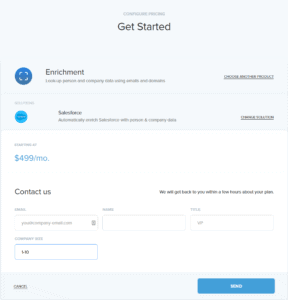
-
-
- 2th case: enrichment of 10,000 segments. Price: $199 per month
-
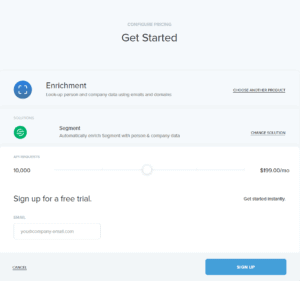
-
-
- Case 3: Email enrichment using Clearbit API data. Price for 10,000 requests: $199 per month.
-
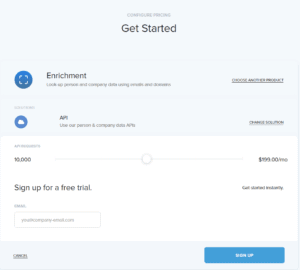
B2C email enrichment prices
Let’s take the example of FullContact. This service provider works on the basis of a match, i.e. a correspondence between one of your contact files and this contact file present in the FullContact API with enriched data. Without a return with qualified information from FullContact, you do not pay.
API plans for software developers :
